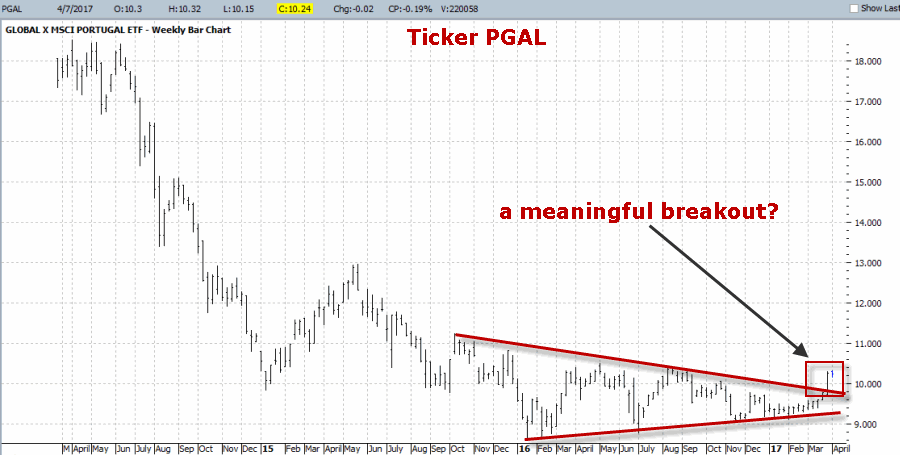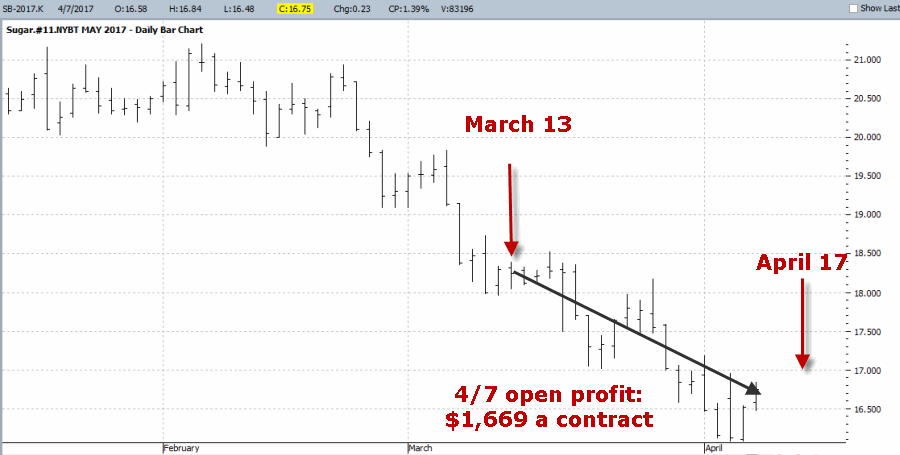Definition of “experience”: Sticking around long enough to pick up a couple of things. In the financial markets, prices go up, prices go down and prices go sideways. This is a universal truth. The trick is figuring out which security is doing what. Let’s take a look across the spectrum.
UP: Ticker PGAL
Now when most people think of “exciting investment opportunities” the country of Portugal is typically not one of the first things to pop into people’s heads. On the other hand, if you say that a given security is “consolidating”, “compressing”, “coiling” and/or “trading in an ever narrower range”, then a lot of people who look at stock charts will sit up and take notice.
In this article I noted the fact that ticker PGAL (an ETF that tracks an index of companies in, yes, Portugal) was doing all of the above on a monthly, weekly and daily bar chart. Sure enough the shares broke out to the upside and now appear to have broken its previous long term downtrend. Figure 1 – Ticker PGAL (Courtesy ProfitSource by HUBB)
Figure 1 – Ticker PGAL (Courtesy ProfitSource by HUBB)
So is it clear sailing from here? Not necessarily. $10.50 could prove to be a strong resistance area and PGAL could fall back lower in the $8.59 to $10.50 a share range. But the two key takeaways are
1) This could be one to keep an eye – particularly if it can top $10.50 a share.
2) In this case experience teaches us that the “range bound consolidation” is something to always be on the lookout for.
DOWN: Sugar
In this article I highlighted the tendency for the sugar market to experience consistent weakness in the March/April time frame. This year that period extends from the close on 3/13/2017 through the close on 4/17/2017 (NOTE: the original article stated that the end date as 4/14 but that is Good Friday and the markets are closed. So April Trading Day #10 is 4/17). As you can see in Figure 2, July sugar futures have so far declined from 18.21 to 16.72. At $1,120 for each one full point in movement in the futures contract, this represents a profit of $1,669 on each futures contract sold short.
 Figure 2 – July Sugar futures (Courtesy ProfitSource by HUBB)
Figure 2 – July Sugar futures (Courtesy ProfitSource by HUBB)
Still, it is important to note that this period does not end until the close on Monday 4/17, so the “jury is still out”. In any event, experience teaches us that persistent seasonal trends can be useful in telling trader “where to look” for a new opportunity.
Sideways: T-Bonds (Ticker TLT)
In this article I noted a bearish setup in t-bonds and highlighted an example option trade on the ETF ticker TLT (that tracks the long-term treasury bond) designed to take advantage of that possibility. TLT subsequently declined from 121.29 to 117.78 a share, generating an open profit on the original option trade.
Then in this article I highlighted an “adjustment” to the original trade designed to lock in a profit while still allowing for further profit potential. Since that time ticker TLT have advanced from 117.78 to 120.71. As you can see in Figure 3, the original trade gave up its open profit and is now sitting with a loss of -$546 with a maximum of -$973 and needs a meaningful decline to ensue between now and April 21st in order to generate a profit. Figure 3 – Original TLT option position (Courtesy www.OptionsAnalysis.com)
Figure 3 – Original TLT option position (Courtesy www.OptionsAnalysis.com)
In Figure 4, we see that the adjusted trade – barring a sharp decline by bonds prior to 4/21 – will settle for a profit of $269. While this “ain’t all the money in the world”, it’s a lot better than generating a profit of +$742 and then riding it back down to a loss of -$973.
In any event the real point is to highlight that by trading options a trader can “adjust” positions along the way – in many cases allowing them to “lock in a profit” and then “let the adjusted position ride.” Figure 4 – Adjusted TLT option position with a “locked in” profit (Courtesy www.OptionsAnalysis.com)
Figure 4 – Adjusted TLT option position with a “locked in” profit (Courtesy www.OptionsAnalysis.com)
In this case, experience teaches us that profits on option trades can be fleeting and that “locking in a profit” is rarely ever the “worst idea.”
Summary
In the course of three very different markets we find that:
1) Consolidation patterns and break outs from those patterns can often highlight terrific buying opportunities.
2) Persistent, long-term seasonal trends can help highlight unique trading opportunities
3) It is always important to remember that trends can reverse quickly and that by using option strategies it is possible to “adjust” a profitable position to lock in profits.
Now if you will excuse me I am going to go upstairs and lie down, um, sideways.
Jay Kaeppel
Disclaimer: The data presented herein were obtained from various third-party sources. While I believe the data to be reliable, no representation is made as to, and no responsibility, warranty or liability is accepted for the accuracy or completeness of such information. The information, opinions and ideas expressed herein are for informational and educational purposes only and do not constitute and should not be construed as investment advice, an advertisement or offering of investment advisory services, or an offer to sell or a solicitation to buy any security.

